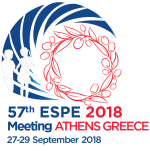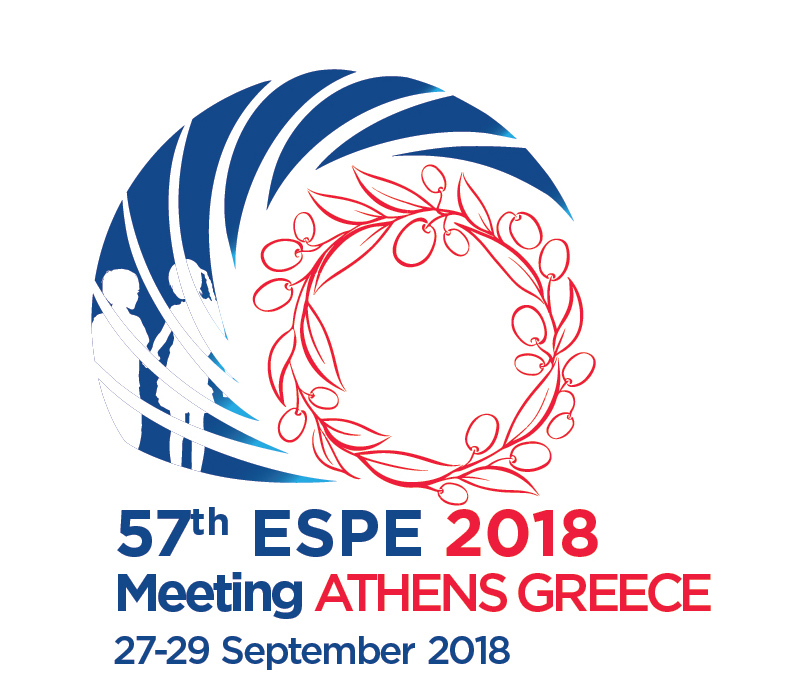
57th Annual ESPE
Athens,
Greece
27 Sep 2018 - 29 Sep 2018

Poster Presentations
Pituitary, Neuroendocrinology and Puberty P1
hrp0089p1-p194 | Pituitary, Neuroendocrinology and Puberty P1 | ESPE2018
A 7-Year Update Report of a National, Interdisciplinary Endeavour to Improve Outcomes for Children and Young People Under 19 Years of Age with Hypothalamic Pituitary Axis Tumours (HPAT) Using Multi-site Video Conferencing
Freund Katja , Malhorta Neha , Dastamani Antonia , Dorward Neil , Aquilina Kristian , Chang Yen-Ching , Mankad Kshitij , Pettorini Benedetta , Blair J Jo , Kamaly Ian , Clayton Peter E , Hargrave Darren , Korbonits Marta , Spoudeas Helen A
hrp0089p1-p195 | Pituitary, Neuroendocrinology and Puberty P1 | ESPE2018
Long Term Reversibility of Presumed ACTH Deficiency (ACTHd) in Children and Young People (CYP) with Intracranial Germ Cell Tumours (IGCT)
Pieri Kyriaki , Michaelidou Maria , Chatoo Zaynab , Holloway Ross , Dastamani Antonia , Spoudeas Helen A
hrp0089p1-p196 | Pituitary, Neuroendocrinology and Puberty P1 | ESPE2018
Endocrine Follow-up of Children with a History of Brain Tumour: Data from Our Large Cohort at Necker University Hospital, Paris, 2010–2015
Briceno Laura Gabriela Gonzalez , Samara-Boustani Dinane , Beltrand Jacques , Grill Jacques , Puget Stephanie , Dufour Christelle , Sainte-Rose Christian , Alapetite Claire , Pinto Graziella , Touraine Philippe , Valteau-Couant Dominique , Kariyawasam Dulanjalee , Aerts Isabelle , Beccaria Kevin , Bourgeois Marie , Roujeau Thomas , Blauwblomme Thomas , Rocco Federico Di , Thalassinos Caroline , Zerah Michel , Pauwels Christian , Brugieres Laurence , James Syril , Busiah Kanetee , Simon Albane , Bourdeaut Franck , Bolle Stephanie , Fresneau Brice , Michon Jean , Orbach Daniel , Guerrini-Rousseau Lea , Doz Francois , Polak Michel
hrp0089p1-p197 | Pituitary, Neuroendocrinology and Puberty P1 | ESPE2018
A Single Centre Experience of Managing a Series of Childhood Macro/Giant-Prolactinoma
Dastamani Antonia , Bulwer Chloe , Ederies Adhraf , Jeelani Owase , Fersht Naomi , Aquilina Kristian , Korbonits Marta , Spoudeas Helen
hrp0089p1-p198 | Pituitary, Neuroendocrinology and Puberty P1 | ESPE2018
A National UK Guideline for Managing Pituitary Adenomas in Children and Young People Under 19 Years Developed According to the AGREE II Framework
Blair Jo , Korbonits Marta , Ronaldson Amy , Dang Mary N , Spoudeas Helen
hrp0089p1-p199 | Pituitary, Neuroendocrinology and Puberty P1 | ESPE2018
Growth Hormone Deficiency and Cryptorchidism in a Family with Xq26.3 Duplication and Position Effect on SOX3
Reschke Felix , Jahn Arne , Tzschach Andreas , Schallner Jens , Hagen Maja von der , Huebner Angela
hrp0089p1-p200 | Pituitary, Neuroendocrinology and Puberty P1 | ESPE2018
PROKR2 Mutations in Patients with Growth Hormone Deficiency and Multiple Pituitary Hormone Deficiency
Najaflı Adam , Baş Firdevs , Karaman Birsen , Al Aslı Derya Kardelen , Toksoy Guven , Poyrazoğlu Şukran , Uyguner Oya , Avcı Şahin , Altunoğlu Umut , Ozturan Esin Karakılıc , Başarn Seher , Darendeliler Feyza
hrp0089p1-p201 | Pituitary, Neuroendocrinology and Puberty P1 | ESPE2018
Anastrozole is Safe as Monotherapy in Early Maturing Girls with Compromised Growth, Further Improving Gain in Predicted Adult Height by the Initial Combination Therapy of an LHRH Analogue and an Aromatase Inhibitor: Results from the ‘Gail’ Study ISRCTN11469487
Dermitzaki Eleni , Kleanthous Kleanthis , Papagianni Maria , Attilakos Achilleas , Mastorakos George , Papadimitriou Anastasios , Papadimitriou Dimitrios T
hrp0089p1-p202 | Pituitary, Neuroendocrinology and Puberty P1 | ESPE2018
Long-acting Octeotride Treatment in Children with Neurofibromatosis Type 1 - Optic Pathway Tumors and Growth Hormone Excess
Guiraldo Paula Ximena Molina , Hernandez Hector Salvador , Bartomeu Joan Prat , Paula Casano Sancho
hrp0089p1-p203 | Pituitary, Neuroendocrinology and Puberty P1 | ESPE2018
Serum Concentrations of the Endocrine Disruptors-organochlorine Pesticides (OCPs) in Greek Children with Neurodevelopmental Disorders
Makris Gerasimos , Chrousos George , Sabico Shaun , Abd-Alrahman Sherif , Al-Daghri Nasser , Chouliaras George , Pervanidou Panagiota
hrp0089p1-p204 | Pituitary, Neuroendocrinology and Puberty P1 | ESPE2018
Whole-exome Sequencing Identifies Novel Pathogenic Variants in Korean Families with Central Precocious Puberty
hrp0089p1-p205 | Pituitary, Neuroendocrinology and Puberty P1 | ESPE2018
A Paternally Inherited Familial Precocious Puberty Caused by a Novel MKRN3 Frameshift Variant
Odone Jessica , Nicholls Rachel , Yadlapalli Kumar , Crowne Elizabeth , Turnpenny Richard
hrp0089p1-p206 | Pituitary, Neuroendocrinology and Puberty P1 | ESPE2018
MKRN3 Levels in Girls with Central Precocious Puberty During GnRHa Treatment: A Longitudinal Study
Grandone Anna , Cirillo Grazia , Sasso Marcella , Luongo Caterina , Tornese Gianluca , Festa Adalgisa , Giudice Emanuele Miraglia Del
hrp0089p1-p207 | Pituitary, Neuroendocrinology and Puberty P1 | ESPE2018
Urinary Gonadotropins as a Useful Non-invasive Marker of Central Precocious Puberty
Hwang Il Tae , Jeong Hwal Rim , Yang Seung , Shim Young Suk
hrp0089p1-p208 | Pituitary, Neuroendocrinology and Puberty P1 | ESPE2018
Testicular Development and Puberty in Boys with Duchenne Muscular Dystrophy: Results From the ScOT-DMD Study
Denker M , Joseph S , DiMarco M , Dunne J , Horrocks I , Ahmed SF , Wong SC
hrp0089p1-p209 | Pituitary, Neuroendocrinology and Puberty P1 | ESPE2018
Exposure to BPA and Phthalates and Timing of Puberty in Girls
Deodati Annalisa , Bottaro Giorgia , Tait Sabrina , Maranghi Francesca , Busani Luca , Rocca Cinzia La , Tassinari Roberta , Carli Fabrizia , Latta Veronica Della , Buzzigoli Emma , Gastaldelli Amalia , Cianfarani Stefano
hrp0089p1-p210 | Pituitary, Neuroendocrinology and Puberty P1 | ESPE2018
Hypothalamic-pituitary-testicular Axis Response to Sub-maximal Aerobic Exercise, in Pre- and Early- Pubertal Normal Weight and Obese Boys
Paltoglou George , Avloniti Alexandra , Chatzinikolaou Athanasios , Mantzou Aimilia , Stefanaki Charikleia , Papagianni Maria , Fatouros Ioannis , Mastorakos Ge
hrp0089p1-p211 | Pituitary, Neuroendocrinology and Puberty P1 | ESPE2018
Effect of Pubertal Blockade and Cross-sex Hormone Treatment on the Growth Spurt in Young Transgender Adolescents: A First Report
Catanzano Matteo , Butler Gary
hrp0089p1-p212 | Pituitary, Neuroendocrinology and Puberty P1 | ESPE2018
Real-World Safety Data in a Cohort of Children with Noonan Syndrome Treated with GH: Final Results from NordiNet International Outcome Study (IOS) and ANSWER Program
Juliusson Petur Benedikt , Dahlgren Jovanna , Abuzzahab M Jennifer , Pedersen Birgitte Tonnes , Roehrich Sebastian , Romano Alicia



